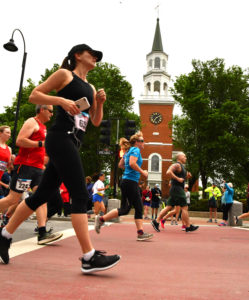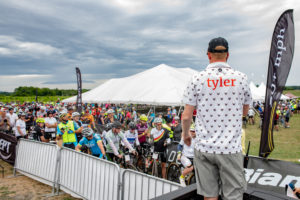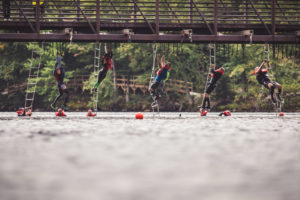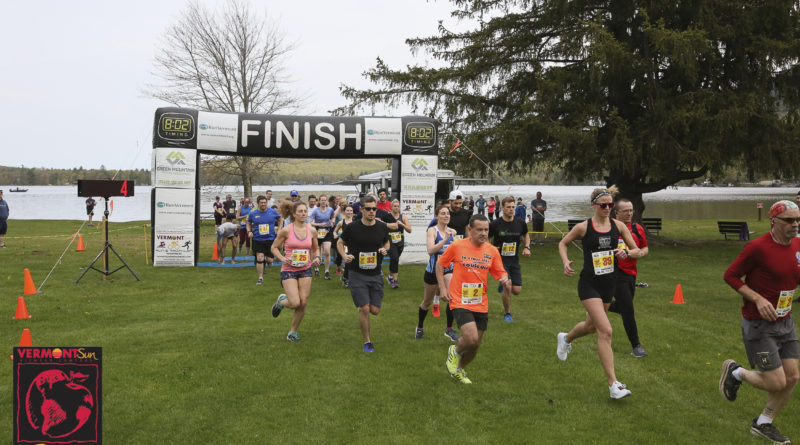Is Vermont Race Ready?
The first race Steve Hare had planned 2020 for was supposed to take place on Sunday, May 17: a half-marathon that would send 200 or so runners from Branbury State Park 13.1 miles along the shores of Lake Dunmore in Leicester. “As the news came out in March, I realized there was no way we could run this event in May,” said Hare, who also owns Vermont Sun Fitness Centers in Middlebury and Vergennes.
He began looking at new dates and laying out plans for how to host a Covid-19-safe event, noodling over everything from how runners would pick up their registration packets to how water and food stations would operate.
But with Gov. Scott’s March 24 executive order banning gatherings, it became clear that races and events all over Vermont would need to reevaluate.
“We realized quickly that with the governor’s order we couldn’t do it in May. So we scheduled for June 14 with plenty of new safety measures,” says Hare who has run the Vermont Sun Triathlon Series on Lake Dunmore for 35 years.
Canceled, Postponed, Virtual?
As Covid-19 spread, race and event organizers around the state began canceling, postponing, or going virtual with their events. USA Cycling pulled the permits for all sanctioned events up to May 31. The Vermont City Marathon, traditionally held Memorial Day, was moved to a “tentative” date of October 25. The epic gravel ride, Rasputitsa, which has drawn 1500 gravel riders to the Northeast Kingdom in April was moved, tentatively to July 25, and another spring classic, the Vermont Overland Maple Adventure Ride paired itself with it, moving from April in Reading to East Burke on July 26.

Tyler Wren’s Farm to Fork Fondo and a new race, the Farm to Fork Fitness Run in the Champlain Islands, were both pushed back from July to Labor Day weekend. “We were hoping that by then we’d be in a better place,” said Wren who typically sets up long tables to serve farm-fresh fare to riders and runners. But on May 10 he shared the news that he was canceling all of his Farm to Fork fitness events —runs and rides now held in six states—and pivoting to small organized group rides for 2020.
Three of the region’s largest charity rides all made early decisions to go virtual. “We decided we really needed to shift the Point to Point, powered by VSECU to a virtual event,” says Simeon Chapin, of VSECU. The day of riding and running to benefit the Vermont Food Bank had been scheduled for Aug. 1. Registration fees were either refunded or donated. Virtual participants, Chapin said, would still receive their goody bags and T-shirts but would run and log miles on their own.
The pivot to virtual did have some benefits: “The Point to Point is all about fighting hunger. We wanted to act immediately and support Vermonters now, when they need it most. We started by sending all funds raised to the Vermont Foodbank each month rather than holding them until the event,” said Chapin.“With a virtual event, we can reduce the overhead cost, slash registration fees, engage riders and runners anywhere in the world, and push all of our resources into helping our community rise to this immediate challenge.”
The Vermont Adaptive Charity Ride, originally slated for June 20, also went virtual, offering people a variety of ways to log just about any activity and promised a virtual party on June 20 with live music shared online and prize give-aways. “People really want to help, and I think many realize the folks we work with at Vermont Adaptive, they’re stuck inside, they don’t have the option of getting out. The $300,000 we typically raise is critical to helping them,” said Communications Director Kim Jackson.
The Prouty, which could have brought 4,000 people to the Upper Valley on the weekend of July 11 to ride, run, row, golf and participate in dozens of events to raise funds for the Norris Cotton Cancer Research Center is also going virtual. There are no longer any minimum fundraising requirements and participants can log their progress any time between June 1 and July 11, doing any sport imaginable—from golf to cycling, running to rowing.
And in a creative twist, The Dirty Project – a 100-mile gravel ride that fundraises as part of The Prouty— announced it would hold a three-stage virtual “audax” – a cycling event that challenges riders to cover as much distance as they can in a set time. The website set the courses and asked participants to complete the rides between June 26 and July 11 and track their progress by GPS.
The fundraising aspect of even smaller virtual races appears to be working. In the Northeast Kingdom, Kingdom Games’ popular Dandelion Run (usually held in May) went virtual with, as organizer Phil White wrote: “84 ‘movers’ already signed on committing 2,263 ‘miles of movement’ between May 16 and May 24th and pledging over $3,200 for Umbrella,” a local organization dedicated to promoting strong women, supported families and safe homes.
This year’s “Dandies” drew people from all over the country to participate. Many were running or walking. Some were spinning and swimming. Bill Brown of Vineyard Haven, MA rowed 31 miles. Karina Palmarino of Magog, QC and Gary Golden of Burlington, each took on 150 miles, kayaking and biking their miles.

But not every event could go virtual.
Gary Kessler who has been planning the 20th running of the Green Mountain Stage Race, the largest pro-am road cycling stage race in the East, also looked into running his race online. “I actually talked to some of the indoor virtual cycling platforms such as Rouvy or Zwift about hosting this. I thought how easy would it be if I could upload video of our routes and have everyone race virtually.”
But as Kessler thought through it, he began to see challenges to hosting a virtual version of a race that awards $35,000 in prize money. “It’s just too easy to cheat – to input a different weight or to put an electric assist bike on a trainer,” he noted. “But the real reason? Cycling is a sport that’s about strategy, it’s about interaction, it’s about talking with your teammate in a peloton or gauging how a competitor is breathing to see if you can break away from him or not. That just doesn’t happen virtually.” For now, the event is still on for Labor Day weekend.
And Who Will Come?
Perhaps a bigger question than how races would be run this summer (and thereafter) is whether or not participants are ready and where they will come from.
On May 6, Road Runners Club of America announced the results of a survey that gleaned information from more than 10,000 respondents. Forty three percent said they would return to running with a group once health guidelines permitted this. And 53 percent said they would participate in events later on in 2020.
The size of the event factored into that decision. While 60 percent said they would be comfortable in an event with up to 250 people, only 34 percent felt comfortable with an event with more than 1,000 attending.
Those numbers echoed a survey sent out in early May by the Champlain Valley Expo on behalf of a group of Vermont event venues and hospitality businesses. Of the 6,331 respondents, 60 percent said they would not attend an event at this time or would only do so if it had 200 people or fewer.
“The challenge for the Vermont City Marathon and other big events is that if you are going to put on a race for 1,000 people the expense side is really not that different than a race for 5,000 people,” notes Peter Delaney, Executive Director of RunVermont which puts on the Burlington event.
Delaney also noted that of the marathon and relay runners who sign up for VCM, “about 50 percent come from out of state.” Delaney still lists the 2020 VCM, now scheduled for October, as ‘tentative’ and RunVermont has created a series of virtual 5Ks to help fundraise.
Concern about out-of-state participants was what led Tyler Wren to finally cancel his Farm to Fork events. “I started thinking about what it would mean to bring 1,000 people to ride around this beautiful, rural part of the Champlain Islands where we’ve only had a couple of cases of Covid-19. It just didn’t seem like the right thing to do.”
Heidi Myers and Tony Moccia who put on Rasputitsa, the spring gravel race in East Burke had similar concerns. Said Meyers. “It’s hard to know what the right thing is to do. On the one hand, this race has filled just about every bed and hotel room in our region. But on the other, we’ve built our race on community and inviting 1500 people from 36 or 40 states and 3 or 4 countries into our community may not be the best thing to do this year.” Meyers was waiting to see where things stood in early June before calling the race one way or the other.
For many races, the economic impact goes far beyond just what entry fees and hotel registrations bring in. Vermont City Marathon historically draws as many as 7,500 runners and 25,000 spectators to Burlington and, Delaney estimates, brings in $3.5 to $4 million in spending to the region.
For Adam Schalit, who runs 13 races in southern Vermont as part of Northeast Trail Runs, the season is still in limbo. “We’ve paused all registration so are not booking new registrations,” he says. However, the first of his events the Ethan Allen 24, a 24-hour track race on a 6-lane track on July 11, had international runners slated to compete. “I just don’t see how we can run this on a 6-lane track. The issue, too is that the food and aid station and the socialization are as much as the race experience.”
Schalit, whose sole income is from his event business, has written Gov. Scott asking for both guidance on how to run races safely and legal protection so that he can defer entry fees to a later event.
“But the main thing,” he says, “is we need to maybe put off races now so that we can run them in the future. Our mission as race directors is to preserve the safety of the participants and the community around us. I’d hate to host a race and then discover that Manchester or wherever we had it had become a new hot spot.”
The Show Goes On
Yet more than one event organizer was moving full-speed ahead. “I guess everything is on until it isn’t,” said Russ Scully who owns WNDNWVs and puts on Stand Up for the Lake, the annual stand-up paddleboard races out of his Burlington Surf Club. “It’s pretty easy for us to do this event and maintain social distancing and other healthy practices.”
 Spartan is still planning its 50K Ultra and 21K Beast races for Killington on Sept., bringing what has traditionally been close to 10,000 participants from all over to the resort just 8 miles south of Spartan founder Joe De Sena’s Pittsfield farm.
Spartan is still planning its 50K Ultra and 21K Beast races for Killington on Sept., bringing what has traditionally been close to 10,000 participants from all over to the resort just 8 miles south of Spartan founder Joe De Sena’s Pittsfield farm.
“We’ve been working with local governments to obey all the rules and have cancelled 30 or so of the 70 races we had planned for 2020,” says Mike Morris, Spartan’s VP of Operations. “But I’m confident we can do this safely in Killington as that event is not until September.” Plans to do so include taking the temperatures of all racers, limiting the number of people in each wave and having hand sanitizer at each obstacle. “We just ordered about $80,000 of hand sanitizer,” Morris says.
For weeks, Steve Hare had been busy mapping out precautions for his June 14 half marathon and his summer-long Vermont Sun Triathlon Series. He planned to have all participants and race personnel wear masks and practice social distancing during all pre-race and post-race activities. Participants would self-serve as they picked up their timing chip and registration and goody bag pick-ups would be spaced out. The starts would be in small waves with only 10 to 20 athletes at a time. Only bottled water and packaged foods would be served. Athletes would pick up their own trophies and there will be plenty of sanitary wipes.
For the triathlons, waves would be spaced farther apart.
Waiting, Wondering
In May, Hare got notice that the permit he had applied for in September for his Branbury State Park races was denied based on the governor’s orders banning small gatherings. “It took me 8 months to get that permit. Reapplying isn’t really an option now,” said Hare. “We’d love to get some guidance from the state, something that would help us look forward and know what we can or can’t do,” said Meyers “just not knowing is the hardest thing.”
VCM’s Peter Delaney, however, did not one silver lining to the pandemic: “We’re seeing a lot of people out running and exercising. It’s similar to what happened in the 2008 recession. In the four or five years after that running saw a real boom.”
Events or no events, the training goes on.
Cover photo: racers at the start of the 2019 Vermont Sun Half Marathon at Lake Dunmore. Courtesy photo.


Catamount outdoor family center is trying something…
http://catamountoutdoorfamilycenter.org/activities/weekly-race-series/